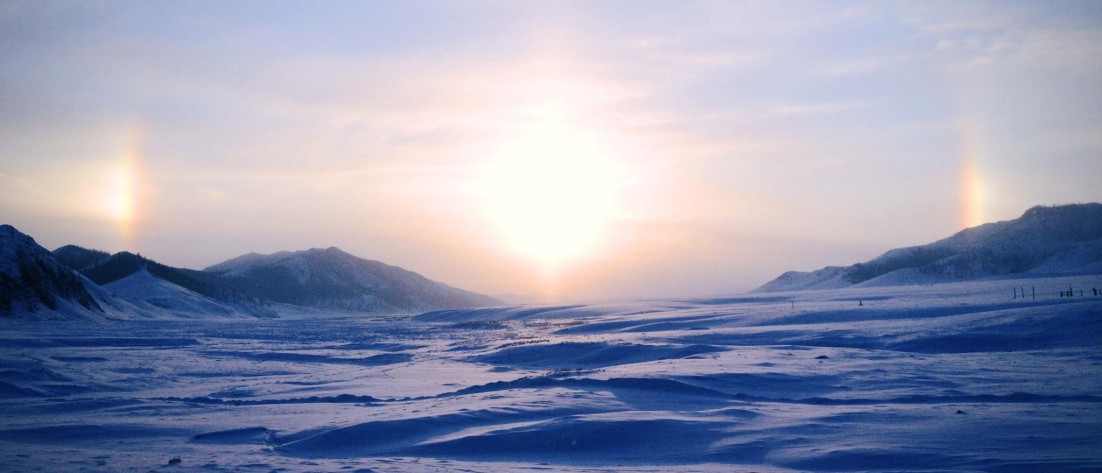Camels! Camels camels camels.
Riding a camel was really one of the only expectations I’d had as far as what I’d do with my time in the Gobi, but almost as soon as I arrived, it started to sound as though I wouldn’t be able to. When Mongolians give you a possible date for something but then push it back every time you ask about it, chances are it’s not going to happen. The camels were really far away, we were told; it was too snowy here, so they’d had to go further out, where there was more food. The roads were bad and they didn’t think we could handle the ride. We would go on Friday, then Saturday, then maybe Sunday if the weather was good.
And then one day one of Eric’s counterparts informed us we’d be leaving at noon the next day. In most of Mongolia, this would mean we wouldn’t actually hit the road until two, but because Delger occupies a hole in the Mongolian space-time continuum, we actually left at ten. It’s a good thing we knew to be ready early, because bundling up for the occasion involved the time-consuming donning of many, many layers.
I could have just worn my coat, of course; since my deel isn’t lined, it’s nowhere near as warm as my winter coat. But if you had a chance to ride a camel in the country’s traditional dress, wouldn’t you? That’s what I thought.
An hour in the car brought us past mountains, roaming herds of livestock, and a strange line at which the snow just stopped. It didn’t correspond with a ridge, or a road, or anything that I could see; nor did it transition gradually. It was like someone had laid a giant tarp across the ground and removed it after the snow ended.
Finally we arrived at a small cluster of gers. We disembarked from the car, pausing so I could put on my deel – hadn’t been wearing it because I knew it would be warm in the car, and I’m more likely to get carsick if it’s too warm – and headed for the nearest one. The guard-kid bleated at us as we approached, so I stopped to take a picture.
What with my (utter lack of) Mongolian language skills, I didn’t really know what was discussed in the ger. Eric attempted to translate huushuur into English, and we learned that “fried pastry” is an amazingly effective tongue twister for Mongolians; as their language contains neither [p] nor [f], they tend not to be able to differentiate between the two sounds. Our hosts threw some buuz in the steamer and handed us steaming cups of milk tea. I sipped politely at mine, glad that southern suutei tsai is made without most of the fat and salt they use up north, but still unable to stomach a large quantity of the stuff. I was glad to be able to hand my bowl off to Eric when he finished his own.
While we waited for the buuz to finish cooking, Eric presented our hosts with a gift to thank them for their hospitality. This is pretty standard anytime you visit someone, but especially when they’re doing you a favor like letting them ride their camels. In that case, there is a specific protocol to follow. You present the gift with both hands; you might need only one to hold the gift, but the хадаг (the ubiquitous ceremonial blue scarf) must be draped across both. And as when doing anything important in Mongolia, you’re supposed to wear your hat.
Finally, the sitting and eating and talking and gift-giving were complete, and our hosts took us out to their camels. There were two saddled, but it seemed we’d only be riding the one. They’re much larger I would have thought; it’s one thing to know an animal’s big, but quite another to stand beside it and observe that its head is roughly the size of your entire torso. We were seeing them in all their winter glory, bulked out by a significant quantity of shaggy hair. In the summer, that hair comes out in patches, leaving the camels looking positively diseased.
I got to go first, and it was clear they had absolutely no faith in my abilities. I was pony-led the entire time, and they told me to hold onto the hump when the camel stood up – a totally unnecessary direction. Camels aren’t exactly graceful when they stand up and sit down, but the motion doesn’t begin to compare to sitting a bucking pony. Like draft horses, camels don’t seem prone to, or even capable of, large sudden movement. Besides, the humps fore and aft of you make for a very secure seat. A comfortable one, too; Mongolian camel saddles are apparently much more padded than the ones they use for their horses.
I was bound and determined to have another turn, especially after they let Eric control the camel himself. And they were kind enough to let me have one. The camel was biddable, but I suppose I would be too if I was being directed through a piercing in my upper lip. He responded to leg pressure too, which is more than can be said of many of the horses here. And he stood and sat in response to verbal commands. He wasn’t happy about it, though. From all his whining, you would have thought we were doing something much worse than walk him around in circles.
I’m not sure what I expected a camel to sound like, but this one certainly defied all my expectations. He moaned and whined and squeaked, emitting noises that doubtless have been used for aliens in movie sound effects. I mean it; that’s the closest comparison I can come up with.
Camels make funny noises. Fancy that.
















